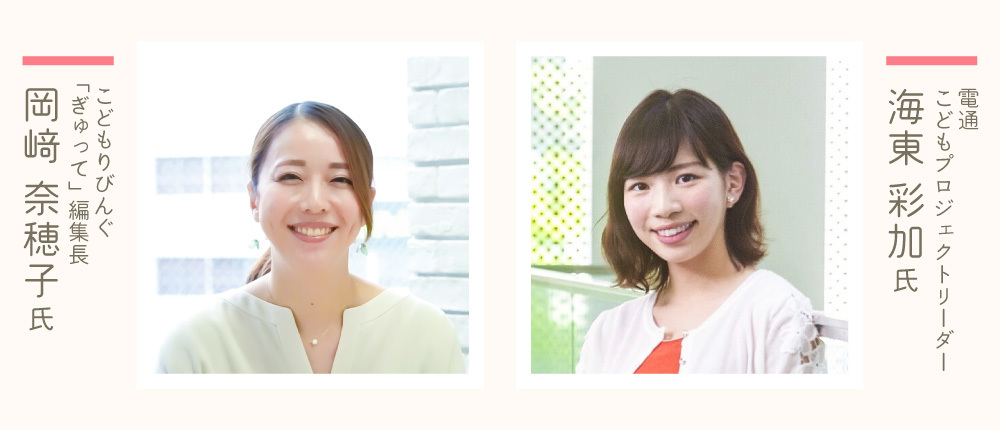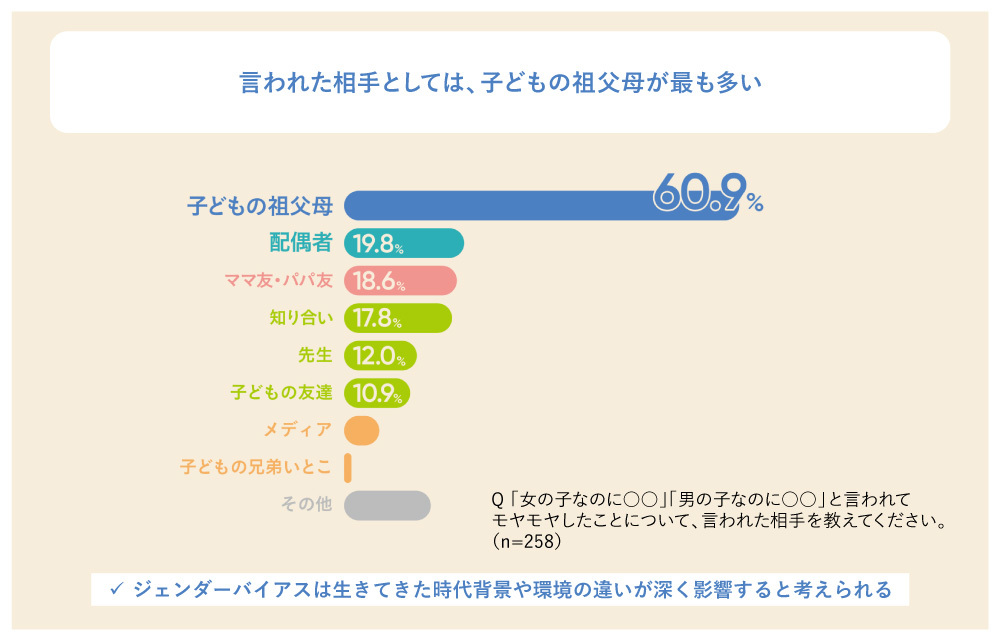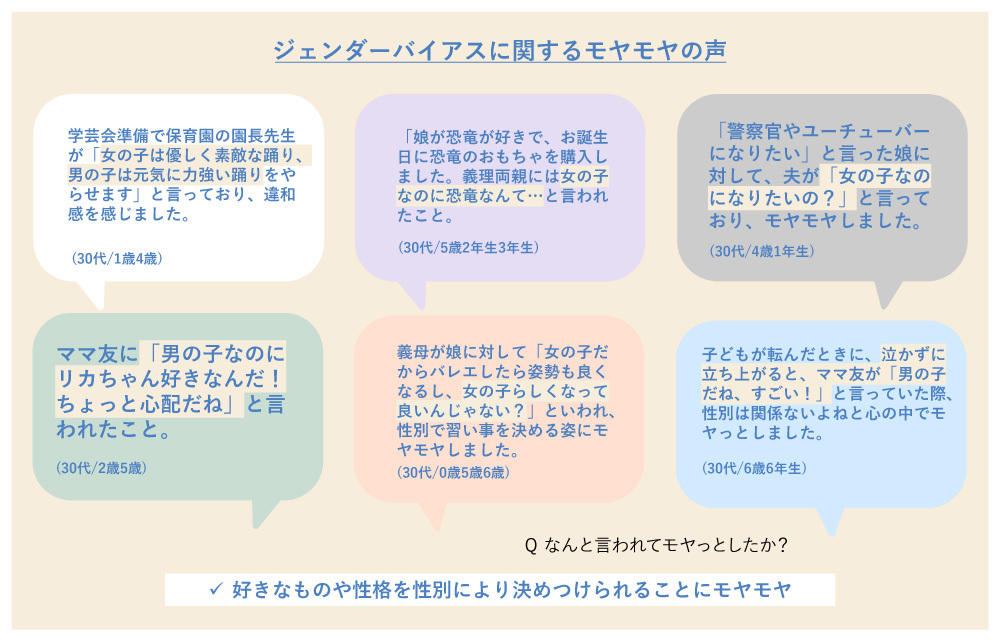Note: This website was automatically translated, so some terms or nuances may not be completely accurate.
Toward a future where children can freely choose their toys, clothes, and school backpacks.

Naoko Okazaki
Kodomori Living Co., Ltd.

Ayaka Kaido
Dentsu Inc.
The Dentsu Diversity Lab, a cross-organizational initiative within the Dentsu Group, and Kodomoringu—publisher of the "Kodomo Project" within the web media cococolor, as well as the magazines Anfan and Gyutte—jointly conducted the "Survey on Perceptions of 'Girl-Like' and 'Boy-Like' Traits in Children" ( see overview here ). This series will explore gender issues surrounding children by examining the survey results.
This time, Ayaka Kaido, Leader of the Children's Project, and Nahoko Okazaki, Editor-in-Chief of Gyutte—an information magazine for parents of nursery school children published by Kodomo Living—discussed the background of this survey, the genuine feelings of parents revealed by the results, perspectives on generational gaps, and the responses expected from companies moving forward.

【Kodomoringu】
A company primarily publishing "Gyutte" and "Anfan," an information magazine for parents of kindergarteners, while also organizing events, sampling activities, and seminars for teachers at kindergartens and nurseries. It consistently shares information closely aligned with the realities of the child-rearing generation. Additionally, through its "Shirumiru Research Institute," it conducts reader surveys and marketing research targeting child-rearing families nationwide, continuously surveying the attitudes of today's parents.
【Children's Project】
One of the projects within the "Dentsu Inc. Diversity Lab." Operating under the broad umbrella of DE&I (Diversity, Equity & Inclusion), it uses the web media "cococolor" to capture social issues from all perspectives, introducing their realities and solutions. As a project considering DE&I for children, it disseminates information through articles and provides solutions.
Related cococolor article: https://cococolor.jp/genderbiasofchildren_220517
Is This Actually "Gender Bias"? Investigating Parents' Perceptions of "Girl-Like" and "Boy-Like" Traits in Children
Kaito: The reason we decided to conduct this joint survey stems from both organizations being involved in child-related activities. It began with the idea, "Can't we do something together?"
Kodomoringu has perspectives aimed at various people like parents and nursery teachers, but talking with them, I strongly felt they really start from the child's perspective. They're actually very close to parents and children, and have connections with nurseries and kindergartens, so I thought we could create a project that effectively leverages that.
Okazaki: For our part, we were planning a cover feature on gender for the November 2022 issue of Gyutte, focusing on respecting children's "likes." The impetus came from my own experience as a parent of a nursery-aged child and an elementary school boy, where I strongly felt gender bias in daily life. I witnessed boys at daycare saying things like, "○○-chan has short hair, so she's a boy, right?" and noticed how characters and colors on belongings were segregated by gender. I was concerned about this when the opportunity for a joint survey arose.
Kaito: The survey's aim was to understand the actual impact on children, especially as gender-related issues are highlighted in SDG goals. The research focused on parents' perceptions of "gender bias" towards children—specifically, their views on "girl-like" or "boy-like" traits. We also asked about awareness of gender bias itself.
Okazaki: Collaborating with the Dentsu Inc. Diversity Lab broadened our approach to question options and drawing conclusions. Since our company has many female employees, we tend to default to female-centric questions and choices. But they suggested having male colleagues review things midway, which taught us a lot.
Kaito: We proposed questions we each wanted to ask, then discussed points like "What about this perspective?" before deciding together. We approach gender bias with the premise that "it's unavoidable for everyone to have some, as it's ingrained by the environment." However, we believe this bias begins forming in young children before they start school. We think unraveling gender bias related to children connects to how adults confront their own gender bias.
70% of parents "feel bias in their own words." We want to create opportunities for parents and children to learn together, starting from "accessible entry points."
Okazaki: Survey results show that about 70% of people have felt gender bias in their own thoughts or words. At the same time, the results indicate that parents don't want their children to develop such biases, suggesting a clear need for action towards equality. While parents likely rarely discuss gender in everyday conversations, I was surprised by how many were conscious of it in this survey.

Kaito: Looking at real feedback about advertising, people seem quite concerned about things like toys and colors being separated by gender. These results also suggest that efforts are needed in areas closely tied to children's daily lives. However, I suspect that currently, many people don't fully grasp the term "gender bias" itself, even if they think they understand it.

Okazaki: At an event we held recently, Mr. Hanzawa, Editor-in-Chief of "cococolor," explained the meanings of "gender," "gender bias," "gender gap," and "gender equality." Currently, it seems many people hear these terms frequently but don't truly understand what they mean. As media, we believe now is the time to provide basic information about gender and create opportunities for learning.
Kaito: I think the "entry point" for learning should be gentle, so it might be good to have spaces where adults and children can learn together. For example, in this survey, we initially planned to include a question using the term "gender bias." However, Kodomoring Living suggested, "If specialized terms appear right at the start, respondents might feel intimidated." That's why we simplified the survey name too.
Even when holding seminars on gender for elementary school parents and children, it's important not to start with "This is what gender means!" Instead, begin with truly relatable themes like "Why are girls' school backpacks red and boys' black?" and let them grasp the concept intuitively without using difficult words.
Okazaki: Translating it into relatable scenes is crucial, right? The most straightforward example often cited these days is restroom symbols. Why blue for men and red for women? I truly believe it's vital for parents to have opportunities to learn alongside their children, grounded in everyday life.
Generational gaps are natural. The key is not to impose your own opinions.

Okazaki: Surveys asking if people had been told "You're a girl (boy) but you're supposed to be..." revealed generational differences in awareness. The biggest gap compared to the parenting generation was overwhelmingly with grandparents. Even our own awareness has changed drastically over the past decade. Considering those in their 50s to 70s, they lived in an era where more rigid expectations of masculinity and femininity existed, so this gap makes perfect sense.
Kaito: I was surprised grandparents ranked so overwhelmingly first. Growing up in fundamentally different environments inevitably creates gaps. However, while holding strong opinions on gender is fine, it's crucial not to impose them on others and to update our thinking as times change.
Okazaki: I thought it would be interesting to hold a roundtable discussion with people from different generations. Also, since the responses included spouses' offhand remarks, it would be great to deepen the discussion with people who have diverse perspectives.

Kaito: Looking at specific comments, one response said, "It's concerning that a boy plays with dolls." I thought that would really sting if someone said that to me. We discovered a lot from these vague, unsettling voices.
Okazaki: Yes. Reading the comments reminded me that since I have two boys, I sometimes casually say things like "Girls are so cute" to families with daughters. Rather than consciously avoiding such remarks, I hope society as a whole evolves so that conversations naturally shift from "Girls are cute" to simply saying "Each child is cute."
Rather than eliminating gender stereotypes, the proposal is for "a wider range of choices to be available."


Kaito: Seeing that one in four people didn't buy a product their child wanted because of gender suggests there's a demand for shopping environments where choices aren't limited by gender. The most common categories people avoided buying were "toys" and "clothes" – items typically sold in separate sections for boys and girls. That's a clear sign of this trend.
I feel that worrying about others' perceptions regarding "girly" or "boyish" traits stems precisely from caring about the child. Parents worry: "If my son plays with dolls, or my daughter wears dinosaur clothes, won't people worry about him? Won't she get bullied?" To alleviate this, I think it's crucial to create environments where girls can easily choose items labeled for boys, and boys can choose items labeled for girls.
Okazaki: There are probably many worries like "Will other parents think it's strange?" Regarding what we just discussed, besides clothing being divided by gender, unisex designs are also emerging. However, rather than focusing on choosing unisex designs, what's important is that children can choose what they genuinely like, whether it's a skirt or pants, regardless of gender. It would be great if we could share information that makes it feel natural for children to choose freely, without imposing parental biases.
Kaito: In California, a law requiring gender-neutral shopping areas will take effect starting in 2024. Movements like this are advancing rapidly not just in Japan. On the other hand, during a Q&A at a recent seminar, someone argued that "separating by gender is convenient." Their point was that since it makes selection easier, keeping separate sections might be acceptable. While separating by gender is one way to simplify choice, I think there are alternatives—like grouping items by type, motif, or color. I want to not just criticize the status quo but also explore ways to improve it.
Okazaki: I understand. At another seminar, someone asked, "What about people who value traditional 'girly' or 'boyish' traits? How do we address their needs?" I don't think we should impose our perspective. Instead, we could offer suggestions like, "Combining the sales areas expands choices and increases enjoyment—that's a positive aspect, right?"
Kaito: Exactly. Framing it as a suggestion—like "Some people might be troubled by gender-segregated displays"—could create a bridge for mutual understanding. With so many perspectives, some might feel their choices—like a girl picking pink—are being criticized. The idea you mentioned—that "kids should be able to choose what they like without question!"—could be one solution.
Breaking gender biases expands children's possibilities
Okazaki: Moving forward, we want to provide learning opportunities for parents and nursery school teachers, and bridge generational gaps through roundtable discussions where different generations share their perspectives and backgrounds. Also, while we're currently discussing parents of elementary school children, opportunities for middle/high schoolers and college students to engage with this topic are increasing. We hope to create learning opportunities for parents of slightly older children too, where they can learn alongside their kids.
Kaito: Opportunities for parents and children, or across generations, to talk are incredibly important for a wide range of people. For the "Children's Project," we want to focus on initiatives that allow children themselves to choose products like toys, school backpacks, and clothes based on their own preferences. We hope to make it easier for them to choose by refining the products themselves and the sales environment, so they won't be rejected by parents or looked at strangely by others.
Hanzawa, editor-in-chief of "cococolor," said that "it's important to feel a sense of discomfort within everyday life," and I really resonated with that. Seeing children's clothing sections divided by gender in stores doesn't usually feel strange, right? But noticing there, "Why are clothes with flowers or hearts grouped as for girls?" is the real first step. I think it's good to start by honing that sensor – questioning things we accept as normal, or feeling a sense of discomfort.
Okazaki: For parents, I want to convey that "that 'normal' might just be 'the parent's normal'." When you feel uneasy about your child's choices, it's good to ask yourself: Is this "normal" just my own "normal"? Also, I'd love for companies to consider creating environments where children can choose from a wide range of options. Preventing the passing down of gender bias to the next generation helps expand children's possibilities.
Graphs and Illustrations Supervised by: Nao Hirano
【Survey Overview】
Title: Survey on Perceptions of "Girl-Like" and "Boy-Like" Traits in Children
Survey Method: Online survey
Survey Participants: 681 parents with children in elementary school or younger, selected from email subscribers of the parenting information sites "Anfan Web" and "Gyutte Web" (nationwide)
Survey Period: February 16 to March 6, 2022
Survey Sponsor: Kodomoring Living Co., Ltd. (Shirumiru Research Institute)
Source: Kodomoring Living "Silmir Research Institute", Dentsu Inc. Diversity Lab
If you enjoyed this article, you might also like:
・What Education Can Do to Uninstall Gender Bias
・Let's Talk About Gender
・Recognizing and Confronting "Hidden Assumptions" ~ Ambass Dialogue
Was this article helpful?
Newsletter registration is here
We select and publish important news every day
For inquiries about this article
Author

Naoko Okazaki
Kodomori Living Co., Ltd.
Gyu Editor-in-Chief
Since 2004, I have been involved in editing local information magazines, joining the editorial department of "Anfan" in 2010. In 2017, I participated in the launch project for "Gyutte." I became Editor-in-Chief of "Gyutte" in 2018. Currently, I am also involved with the "Shirumiru Research Institute," which conducts consumption and behavior surveys for families with preschool-aged children, as well as character business initiatives.

Ayaka Kaido
Dentsu Inc.
Third Integrated Solutions Bureau
Solution Planner
As a Solution Planner, I work in marketing, corporate consulting, product development, and training development. At cococolor, operated by Dentsu Diversity Lab, I lead the Children's Project, writing articles and developing solutions. Other responsibilities include conducting LGBTQ+ surveys, developing the Unconscious Bias training program "Ambush Dialogue," and creating "GAP MIKKE" focused on developmental disorders. My hobbies include playing with my beloved dog and researching dog-related social media.


